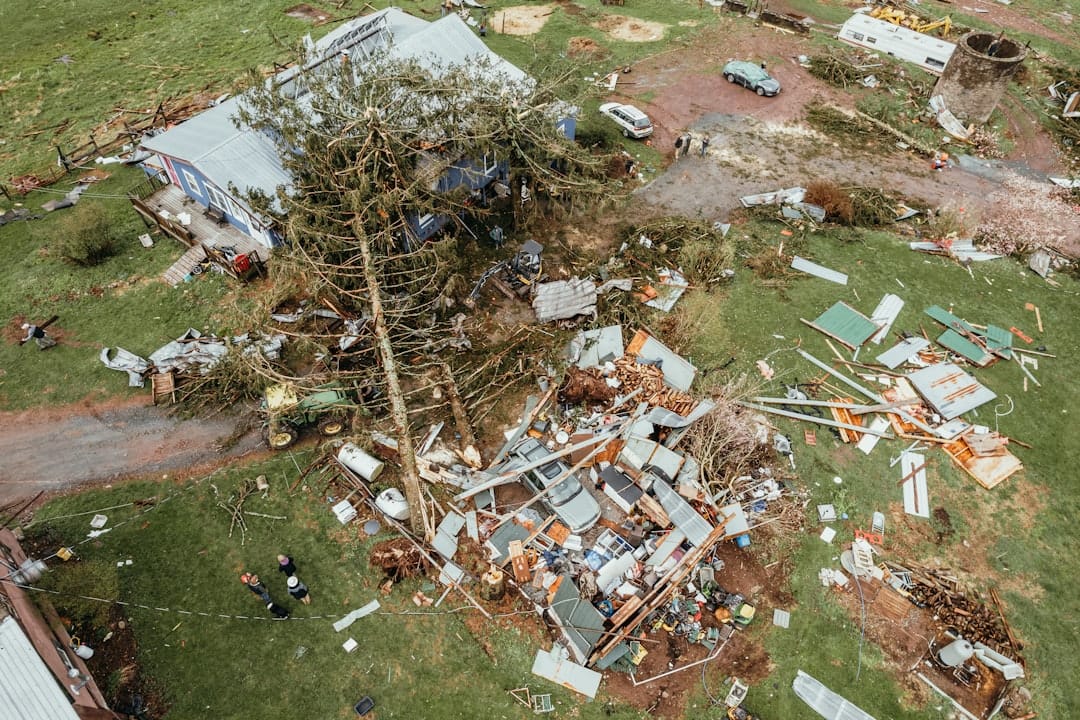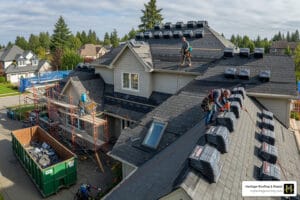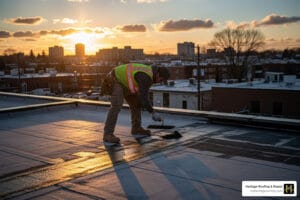Why Understanding Fayetteville Storm Damage Is Critical for Your Recovery
The recent Easter Sunday tornado left significant Fayetteville storm damage in its wake, leaving many property owners overwhelmed and searching for answers. If your home has a damaged roof, broken windows, or structural issues, know that professional help is available. This guide provides the essential steps for a swift recovery.
Key Facts About the Easter Sunday Storm:
- When: Easter Sunday at approximately 2:40 p.m.
- Strength: EF-1 tornado confirmed by National Weather Service
- Location: West side of Fayetteville, particularly areas west of Hughmount Road
- Damage: Over 30 homes affected with roof damage, broken windows, and downed trees
- Areas Hit: Hughmount Village and Salem Hills neighborhoods were hardest hit
- Casualties: No injuries or fatalities reported
The aftermath can feel overwhelming, especially when you’re facing damaged roofs, broken windows, and debris scattered across your property. As resident Adam Rose noted after returning to find his roof punctured and fence destroyed: “When people have damage and stuff like this, people always come together. So that’s really nice to see.”
Time is critical. Quick action protects your property from further harm and is crucial for insurance claims. Whether you need an immediate storm damage roof repair or a full assessment, following the right steps can save you significant time and money.
I’m Rex Wisdom, owner of Heritage Roofing & Repair, and our family has been helping Northwest Arkansas communities recover from Fayetteville storm damage for over 50 years. We’ve guided countless homeowners through the storm recovery process, from emergency repairs to working with insurance adjusters to ensure complete restoration.
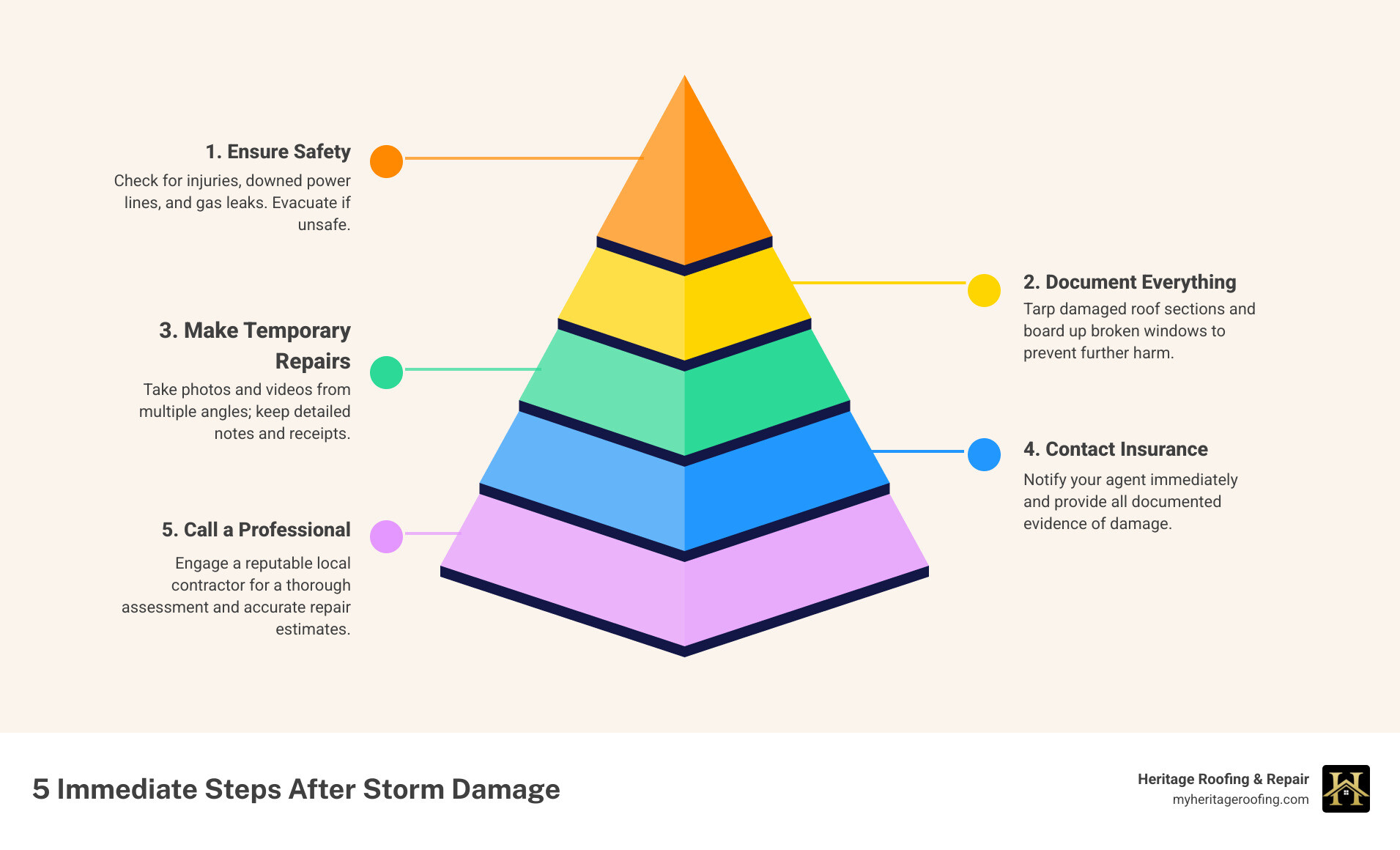
The Easter Sunday Tornado: A Look at the Impact on Fayetteville
The calm of Easter Sunday was shattered for many Fayetteville residents when a powerful storm system swept through, leaving a trail of destruction in its wake. This wasn’t just any storm; it was a confirmed tornado that brought significant changes to the landscape of several neighborhoods.
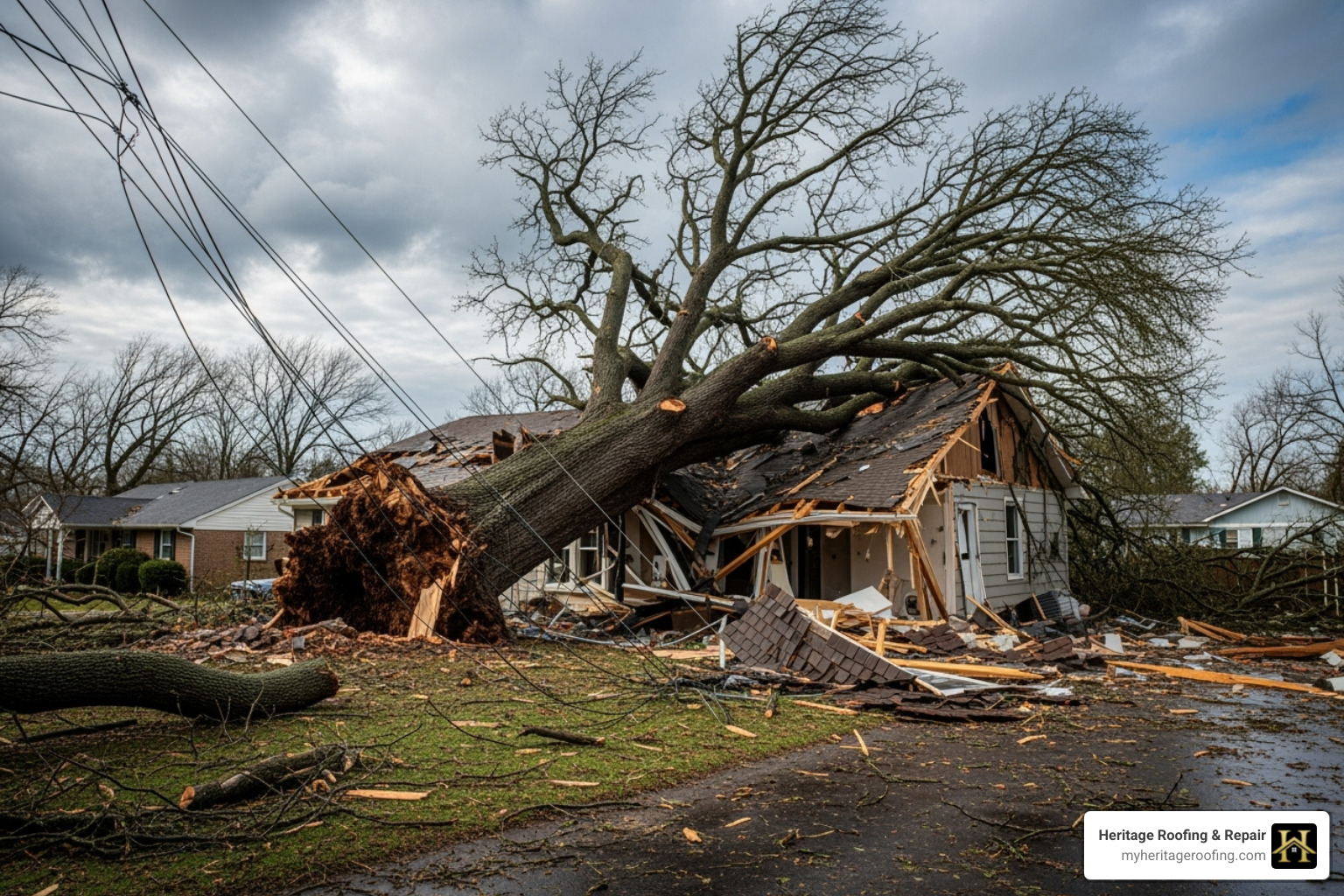
What Happened?
At approximately 2:40 p.m. on Easter Sunday, an EF-1 tornado touched down on the west side of Fayetteville. The National Weather Service confirmed the tornado, with wind speeds of 86-110 mph, cut a path of moderate damage through areas west of Hughmount Road, including the Hughmount Village and Salem Hills neighborhoods. The suddenness of the event left many residents in shock as they emerged to find significant damage to their properties. In the aftermath, Fayetteville neighbors unite after storm damages dozens of homes, showing the community’s resilience.
The Extent of the Damage
While no injuries were reported, the material damage was substantial. Fayetteville Emergency Manager Shane Wood’s initial estimates of 25 damaged homes grew to over 30 as the full scope became clear.
The types of damage varied but commonly included:
- Roof damage: The most common issue, ranging from missing shingles and punctures to sections of roofs being torn off.
- Broken windows: Flying debris caused numerous broken windows.
- Downed trees: Uprooted and snapped trees fell on homes and fences, blocking roads and causing power outages.
- Fence damage: Many fences were damaged or destroyed, with debris like trampolines thrown into neighboring yards.
- Structural issues: Some homes had more significant structural impacts, and damage to city infrastructure like street lights was also reported.
Drone footage from the affected areas captured the widespread nature of the damage, showing a stark reminder of nature’s power and the importance of preparedness.
Community and City Response
In the face of such a sudden disaster, the spirit of Fayetteville shone brightly. The community’s response was nothing short of inspiring.
- Neighbors helping neighbors: Neighbors immediately began helping each other clear debris and offer support, a response one resident called “awesome.”
- City emergency management assessment: Fayetteville Emergency Manager Shane Wood and city officials quickly assessed the damage to coordinate recovery efforts.
- Debris cleanup efforts: City crews, county road crews, and the fire department worked to clear roads and secure damaged homes.
The collective effort underscores the resilience of Fayetteville. To get a broader perspective on storm impacts, you can View the official Storm Report Map which provides an overview of storm reports.
First Steps: What to Do Immediately After the Storm
Once the storm passes and it’s safe, your first actions are critical for both your safety and your future insurance claim. The immediate aftermath can feel overwhelming, but a clear plan helps.
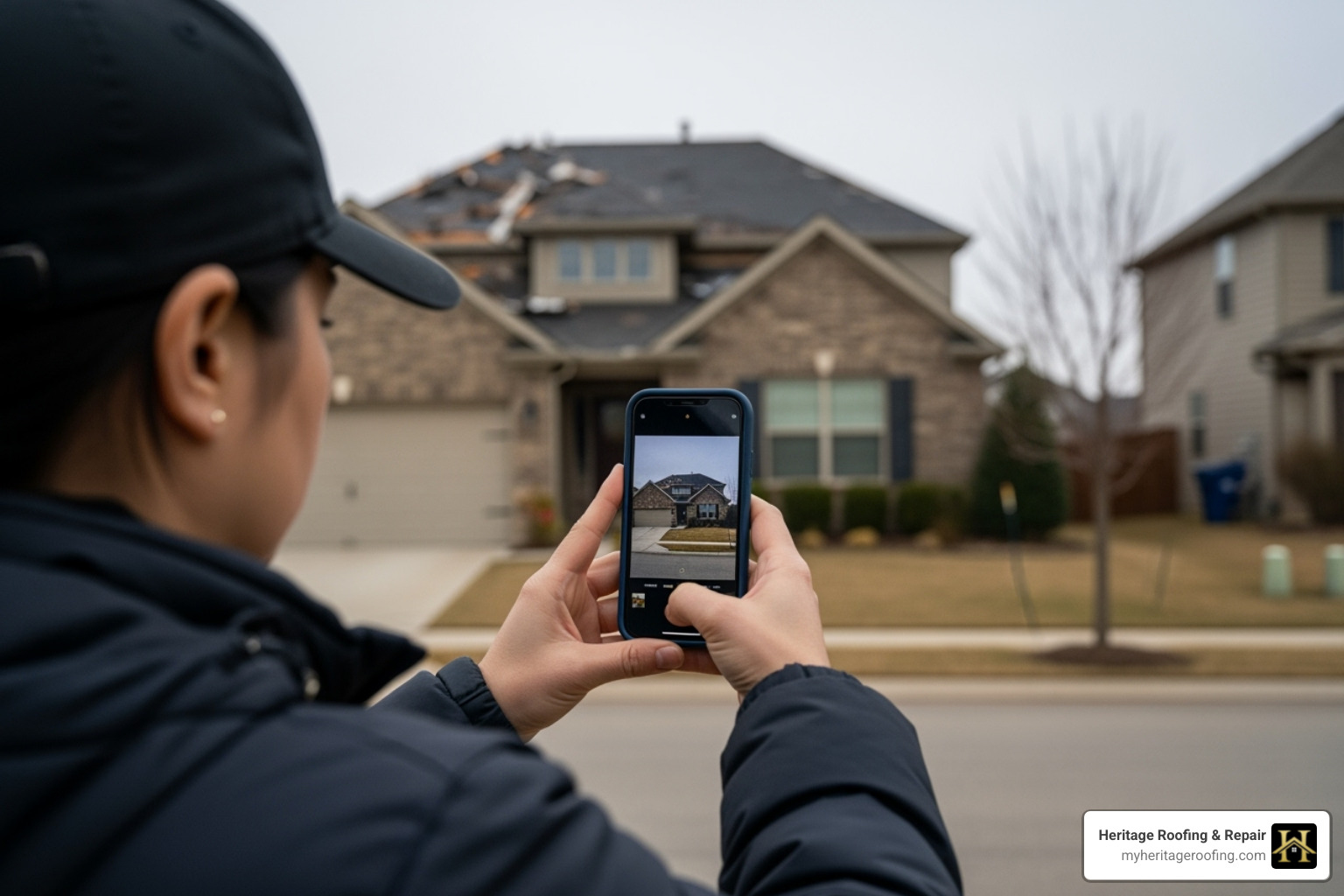
Prioritize Safety
Before you do anything else, ensure that you, your family, and your pets are safe. In the chaos of the moment, it’s easy to overlook critical hazards.
- Check for injuries: Check yourself and everyone around you for injuries and get medical help if needed.
- Watch for downed power lines: Stay far away from downed power lines. Treat them as live and report them to your utility company immediately.
- Smell for gas leaks: If you smell gas or hear a hissing sound, evacuate immediately and call 911 or your gas company from a safe distance.
- Avoid standing water: Avoid standing water, which can hide electrical hazards, sharp debris, and contaminants.
- Evacuate if unsafe: Evacuate if your home has severe structural damage or other hazards like major flooding or gas leaks.
Your well-being is paramount. No property is worth risking your life over.
Document Everything
After ensuring safety, thoroughly document all damage for your insurance claim. This evidence is vital for your home’s recovery.
- Take photos and videos: Take extensive photos and videos of all damage, both inside and out. Capture wide shots for context and close-ups for detail, including personal property.
- Capture damage from multiple angles: Photograph damage from multiple angles. For roof damage, take pictures from the ground or a safe vantage point.
- Write detailed notes: Keep a detailed written log, noting the date, time, and description of all damage observed.
- Keep receipts for all immediate expenses: Save all receipts for immediate expenses like temporary repairs or lodging, as they may be reimbursable. This includes costs for More info about emergency roof repair.
This detailed record will serve as undeniable evidence when you file your claim, helping to streamline the process.
Make Temporary Fixes
After documentation, make temporary repairs to prevent further harm to your property and mitigate additional loss.
- Tarp damaged roof sections: Tarp damaged roof areas to prevent water intrusion, which can lead to mold, rot, and other serious secondary damage.
- Board up broken windows: Board up broken windows with plywood or heavy-duty plastic to secure your home from weather and intruders.
- Remove debris from walkways: Carefully clear debris from walkways, driveways, and entrances to ensure safe access.
- Prevent further water intrusion: Look for other water entry points, like damaged siding, and use buckets or towels to manage interior water.
These temporary solutions buy you time until professional repairs can be made. Tackling extensive repairs yourself can be dangerous and may even void your insurance claim. It’s often best to compare DIY vs. Professional Roofing for safety and effectiveness.
How to Identify and Assess Your Fayetteville Storm Damage
Some storm damage is obvious, like a tree on your roof, but other types can be subtle and lead to major problems if missed. A thorough assessment is key. When assessing Fayetteville storm damage, we look beyond the obvious.
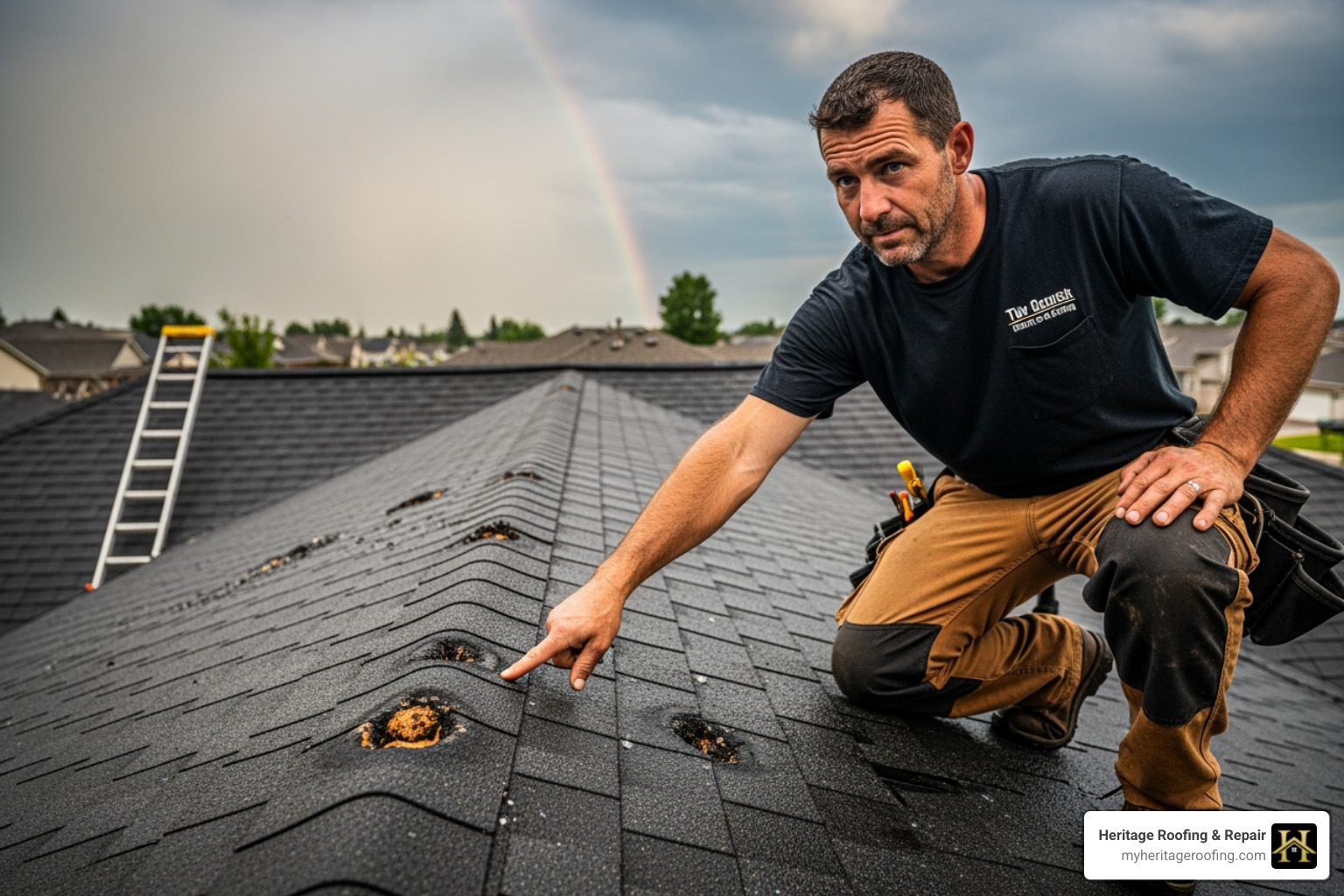
Common Types of Roof Damage
Your roof is your home’s first line of defense and often takes the brunt of a storm. Here are common signs of roof damage we look for:
- Missing or cracked shingles: Look for bare spots on your roof or shingle pieces in your yard, as high winds can easily tear them off or crack them.
- Dents from hail: Check shingles, metal roofing, vents, and gutters for dents. Even small hail can cause damage that shortens your roof’s lifespan.
- Lifted shingle edges: Wind can break the adhesive seal on shingles, leaving them vulnerable to being torn off in the future.
- Granule loss in gutters: A large amount of shingle granules in your gutters indicates impact damage and a weakening of your roof’s protective layer.
- Leaks in the attic: Check your attic for water stains, drips, or visible light, as these are clear signs of roof damage that can lead to mold and structural problems.
Identifying these issues early is crucial. For more detailed information, check out our insights on More info about storm damage roof repair.
Exterior and Structural Concerns
Beyond the roof, storms can impact various other parts of your home’s exterior and even its underlying structure.
- Cracked or dented siding: Inspect all siding for impacts from hail or wind-driven debris.
- Broken windows and frames: Check window glass and frames for cracks, impact marks, or bending.
- Damaged gutters and downspouts: Look for bent, detached, or clogged gutters, which are crucial for directing water away from your foundation.
- Unstable fences or decks: Check for structural damage to fences and decks that could make them unsafe.
- Foundation cracks: Heavy rains can cause soil to shift, so inspect your foundation for any new cracks.
These exterior damages might seem minor, but they are interconnected and can lead to bigger problems if ignored.
Why You Need a Professional Roof Inspection
While a homeowner’s initial assessment is important, it’s no substitute for a professional inspection. Here’s why:
- Hidden damage detection: Professionals can spot subtle damage, like minor hail impacts or lifted seals, that an untrained eye might miss but can lead to major issues.
- Safety: Inspecting a damaged roof is dangerous. Our trained teams use proper safety equipment to perform inspections without risk, especially on steep or high roofs.
- Detailed report for insurance: We provide a comprehensive, unbiased report with photos that adds credibility to your insurance claim and clarifies the extent of the damage for the adjuster.
- Accurate repair estimates: A thorough inspection allows us to provide a precise, transparent estimate, so you understand the full scope and cost of repairs.
A professional More info about roof inspection is the foundation for a successful and complete storm damage recovery.
Navigating Repairs and Insurance Claims
The recovery process involves two key partners: your insurance provider and a trusted local contractor. Choosing the right team can make all the difference in restoring your home efficiently and correctly. Dealing with the aftermath of Fayetteville storm damage is a marathon, not a sprint, and we’re here to help you every step of the way.
Filing Your Insurance Claim
This can feel like a daunting task, but breaking it down into manageable steps makes it easier.
- Contact your agent immediately: The sooner you notify your insurance company about the damage, the better. Most policies have a timeframe within which you must report a claim. Provide them with your policy number and a brief overview of the damage. They will open a claim and assign an adjuster.
- Provide your detailed documentation: This is where all your photos, videos, and notes from your initial assessment come into play. Share everything you’ve collected with your insurance company. The more evidence you have, the smoother the process will be.
- Understand your deductible: Your deductible is the amount you’re responsible for paying before your insurance coverage kicks in. Know what yours is, as it will impact your out-of-pocket expenses.
- Meet with the insurance adjuster: An adjuster will be assigned to your claim to evaluate the damage. We highly recommend having your chosen contractor present during this meeting. Our team at Heritage Roofing & Repair has extensive experience working with adjusters, ensuring that all damage is properly identified and accounted for. We speak their language and can advocate on your behalf to ensure a fair assessment.
Navigating the insurance claims process can be complex, but with proper documentation and professional guidance, it becomes much simpler. Learn more about how we assist with More info about insurance roof claims.
Finding a Reputable Local Contractor
Choosing the right contractor is perhaps the most critical decision you’ll make after a storm. Unfortunately, severe weather often brings out “storm chasers”—out-of-town companies who swoop in, do quick, shoddy work, and then disappear. We strongly advise against these. Here’s what to look for in a reputable local partner:
- Look for local experience: A contractor with deep roots in Fayetteville and Northwest Arkansas understands local building codes, weather patterns, and has a vested interest in the community. Our team has been serving this area for over 50 years, building a reputation for quality and trust.
- Verify license and insurance: Always ask for proof of licensing and comprehensive insurance (liability and workers’ compensation). This protects you from financial responsibility if an accident occurs on your property or if the work is faulty.
- Read recent customer reviews: Check online reviews on platforms like Google, Yelp, and the Better Business Bureau. Look for consistent positive feedback regarding communication, quality of work, and customer service.
- Beware of storm chasers: Be wary of contractors who pressure you for immediate decisions, demand large upfront payments, or solicit door-to-door without a local presence. A reputable local company won’t need to chase storms; they’ll be busy serving their established community.
- Get a detailed, written estimate: A professional contractor will provide a clear, itemized estimate that outlines all the work to be done, materials used, and costs. This ensures transparency and avoids surprises.
We believe in building lasting relationships, not just fixing roofs. Our commitment to quality craftsmanship and customer satisfaction is what sets us apart.
Get Professional Help in the Fayetteville Area
For a trusted, local assessment of your storm damage, you can contact our team. We are here to provide dependable, affordable, and quality craftsmanship, specializing in storm damage repair and insurance claims for local homeowners and businesses.
Heritage Roofing & Repair
3458 Arkansas State Hwy 221, Berryville, AR 72616
(870) 654-1164
Frequently Asked Questions about Fayetteville Storm Damage
We often hear similar questions from homeowners dealing with the aftermath of storms. Here are some of the most common ones, along with our expert answers.
How much does it cost to repair a storm-damaged roof?
The cost to repair a storm-damaged roof varies widely depending on several factors:
- Extent of the damage: Minor damage will be far less expensive than extensive damage requiring a partial or full roof replacement.
- Roofing materials: Asphalt shingles are generally more affordable to repair than specialty materials like tile, metal, or cedar shakes.
- Size and pitch of the roof: Larger and steeper roofs require more materials and labor, increasing costs.
- Underlying damage: Water intrusion can damage decking, insulation, and interior ceilings, adding to the overall repair cost.
Minor repairs may cost a few hundred dollars, while a full replacement can cost thousands. A professional inspection is the only way to get an accurate estimate for your specific situation. For more information, explore our guide on More info about roof repair cost.
Will my homeowner’s insurance cover all the damage from the tornado?
Most standard homeowner’s insurance policies cover wind and tornado damage under your dwelling coverage. However, the exact amount of coverage depends on your specific policy, its limits, and your deductible.
- Deductible: You are responsible for your deductible. Check your policy, as some have a separate, higher deductible for wind damage.
- Policy limits: Your policy has a maximum payout for dwelling damage. You are responsible for costs that exceed this limit.
- Exclusions: Review your policy for any specific exclusions, though they are rare for tornado damage.
- ACV vs. RCV: Understand if your policy pays Actual Cash Value (depreciated value) or Replacement Cost Value (cost to replace with new materials). RCV is generally more favorable.
- Additional Living Expenses (ALE): If your home is uninhabitable, your policy may cover temporary living costs like hotels and meals.
It’s crucial to review your policy and work with your agent and a knowledgeable contractor who can help you understand your coverage.
How can I protect my home from future storm damage?
While you can’t control the weather, you can take proactive steps to reduce your home’s vulnerability to future storms:
- Regular roof maintenance: Have your roof professionally inspected for loose or damaged shingles and keep gutters clean. A well-maintained roof is more resilient.
- Trim trees: Keep branches trimmed away from your house to prevent them from falling on your roof during high winds.
- Secure outdoor items: Bring in or tie down furniture, grills, and trampolines so they don’t become projectiles in high winds.
- Reinforce windows and doors: Consider storm shutters, impact-resistant windows, and a reinforced garage door to prevent catastrophic failure during high winds.
- Invest in impact-resistant roofing materials: When replacing your roof, consider materials rated for high wind and hail resistance. They are a smart investment for long-term protection and may lower insurance premiums.
- Ensure proper drainage: Keep gutters clear and extend downspouts away from your foundation to prevent water pooling and foundation damage.
Being prepared is half the battle. Taking these preventative measures gives your home the best chance to withstand future storms.
Conclusion: Rebuilding a Stronger Fayetteville Together
Recovering from the Fayetteville storm damage is a process, but the incredible community response shows the strength and resilience of our city. From neighbors helping clear debris to city officials coordinating recovery, the spirit of Fayetteville shines through.
By taking these steps—prioritizing safety, documenting damage, making temporary fixes, navigating insurance claims, and partnering with trusted professionals like Heritage Roofing & Repair—you can steer the recovery process with confidence. We understand the emotional and financial toll that storm damage can take, and our goal is to alleviate that burden.
With over 50 years of trusted experience, we are committed to helping our neighbors rebuild with quality craftsmanship and dependable service. We’ve seen countless storms come and go, and we’ve helped countless families restore their homes and their peace of mind. For a comprehensive damage assessment and guidance on your next steps, contact our experts who serve the entire Fayetteville, AR area. Let’s rebuild together, stronger than ever.
